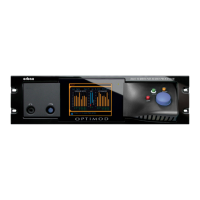1-22
INTRODUCTION ORBAN MODEL 8685
Canny engineers familiarize themselves with the performance of real-world receiv-
ers and reduce the peak modulation of the transmissions if it turns out that most re-
ceivers are clipping due to perceptual encoding overshoots. Our experience to date
suggests that allowing 3dB headroom will prevent audible overshoot-induced clip-
ping in low bite-rate systems (e.g., 32 kbps streams), while 1.5 dB is adequate for
128kbps and above. While some clipping may still occur, it will have a very low duty
cycle and will almost certainly be inaudible.
Streaming and Netcasting Applications
This section was written in mid 2008. As the state of the art in netcasting is changing
with ferocious rapidity, we expect it to become outdated quickly. Please check
Orban’s web site, www.orban.com, for newer information.
Using OPTIMOD 8685 in Streaming Applications
You need an audio source connection (AES3id digital or SPDIF digital for the base
configuration; these options plus HD-SDI audio channels when the optional HD-SDI
module is installed). The 8685 AES3id inputs can accept any sample rate from 20 to
96 kHz. You can also use any stream available within the computer’s internal WAVE
audio system, like a digital playout system. If you use the computer’s WAVE audio
system, you will need a sound card with full duplex capability along with digital in-
puts and outputs. Connect the digital output of the sound card to the 8685’s digital
input and connect the 8685’s digital output to the input of the sound card.
You will ordinarily connect the signal that the sound card receives to the input of an
encoder application, like Orban’s Opticodec-PC. You then apply the encoded output
of the encoder to a netcast server application, which may operate on the same ma-
chine as the encoder, or on a different machine on your network. In the latter case,
you will route the encoded audio to the netcast server application through your
network.
See Processing for Low Bit Rate Codecs on page 3-5.
Loudness
You can expect a significant increase in loudness from OPTIMOD 8685 processing by
comparison to most unprocessed audio.
An exception is recently mastered CDs, which may have already been ag-
gressively processed for loudness when they were mastered.
In radio broadcasting, it is generally believed that loudness relative to other stations
attracts an audience that perceives the station as being more powerful than its
competition. We expect that the same subliminal psychology will also hold true in
netcasting.
For sound-with-picture applications, you can use Dialnorm and one of the 8685’s
“TV” presets to standardize loudness so that it is consistent with other transmissions.
We recommend setting Dialnorm to –24 dB, which is consistent with the ATSC A/85
2009 recommendation and acceptably close to the EBU R 128 recommendation,
which specifies –23 dB.

